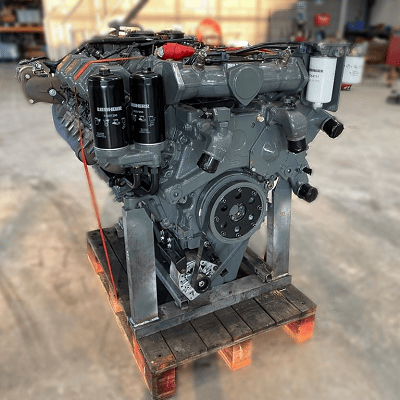The process of a dyno test on a Liebherr engine

When it comes to heavy machinery, reliability and power are paramount. Liebherr, a name synonymous with innovation and excellence in engineering, stands tall as a pioneer in the realm of heavy equipment and machinery. From towering cranes to robust excavators, Liebherr’s engineering prowess extends to the heart of these machines. We delve into the world of dyno testing a Liebherr engine, uncovering the meticulous process behind unleashing the raw power concealed within.
The foundation of excellence
Before we embark on the journey of dyno testing, it’s crucial to understand the foundation upon which Liebherr engines are built. With decades of engineering expertise and commitment to quality, Liebherr engines are crafted to withstand the most demanding environment and deliver unparalleled performance. Each component is meticulously designed and rigorously tested to ensure reliability, efficiency and longevity.
The process
1 Preparation: The engine undergoes meticulous preparation before being mounted onto the dynamo meter. This includes ensuring all connections are secure, fluids are filled to the appropriate levels, and sensors are properly calibrated.
2 Mounting: The engine is carefully mounted onto the dynamometer, a specialized device designed to simulate real-world operating conditions. Precision is paramount during this step to ensure accurate results.
3 Initial checks: Once mounted, a series of initial checks are conducted to verify proper alignment, connection integrity, and functionality of all engine systems.
4 Warm-up: The engine is started and allowed to warm up to operating temperature. This ensures consistent results and minimizes the risk of damage during testing.
5 Baseline testing: With the engine warmed up , baseline tests are conducted to establish initial performance metrics. This includes measuring power output, torque, fuel consumption, and emissions at various RPM levels.
6 Load testing: The engine is subjected to progressively increasing loads to simulate different operating conditions, such as idle, partial load and full load. This allows engineers to assess performance across the entire operating range and identify any potential issues or optimization.
7 Data analysis: Throughout the testing process, data is continuously collected and analyzed in real-time. Advanced instrumentation and software are used to monitor performance metrics and identify trends or anomalies.
8 Optimazation: Based on the data analysis, adjustments may be made to optimize engine performance. This could involve fine-tuning fuel injection timing, adjusting air-fuel ratios, or optimize turbocharger boost pressure.
9 Validation: Once testing is complete, the results are meticulously reviewed and validated against predetermined criteria and specifications. Any deviations or anomalies are thoroughly investigated to ensure accuracy and reliability.
10 Reporting: Finally, a comprehensive report is generated detailing the results of the dyno testing, including performance metrics, observations, and any recommendations for further optimization or refinement.
The outcome of dyno testing
Dyno testing a Liebherr engine is more than just a routine procedure – it’s a testament to the unwavering commitment to excellence that defines Liebherr’s engineering philosophy. By subjecting their engines to rigorous testing and analysis, Liebherr ensures that each engine delivers the uncompromising performance, reliability, and efficiency that customers expect.
In conclusion, dyno testing a Liebherr engine is not just about measuring power output. It’s about unlocking the true potential of these remarkable engines and ensuring they exceed expectations in the most challenging environments imaginable.
Stainless Steel Dutch Woven Mesh
Key Features:
1. Corrosion Resistance: Stainless steel is highly resistant to rust and corrosion, which makes the mesh suitable for use in harsh environments or with corrosive substances.
2. Strength and Durability: The Dutch weave pattern creates a strong and flexible mesh that can withstand high tensile forces without stretching or deforming.
3. Versatility: It can be used in both industrial and commercial applications due to its wide range of sizes and thicknesses.
4. Cleanliness: Stainless steel is easy to clean and maintain, which is beneficial in food processing, pharmaceuticals, and other industries where hygiene is critical.
5. Aesthetic Appeal: The smooth surface of stainless steel mesh can add a modern look to architectural designs.
Uses:
- Industrial Filtration: Used in filters for oil, water, and air purification systems.
- Food Processing: As sieves in food production lines to separate particles of different sizes.
- Pharmaceutical Industry: For filtering solutions, separating bulk materials, and packaging.
- Construction: In architectural applications such as window screens, facade cladding, and security barriers.
- Agriculture: For animal enclosures and protecting crops.
- Environmental Control: In HVAC systems to control airflow and filter out contaminants.
Types:
- Grade 304 (18/8): Commonly used for general applications due to its good balance between cost and performance.
- Grade 316 (Marine Grade): More expensive but offers superior corrosion resistance, making it ideal for marine environments or applications with saltwater exposure.
When selecting stainless steel Dutch woven mesh, consider factors such as the specific application requirements, the level of corrosion resistance needed, and the desired aesthetic or functional properties.
Stainless Steel Dutch Woven Mesh,Micron Stainless Steel Wire Mesh,Micron Stainless Steel Mesh,Micron Filtration Cloth
Hebei Yingkang Wire Mesh Product Co.Ltd , https://www.wiremesh-china.com
